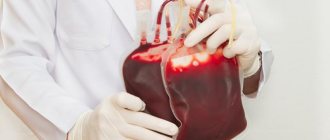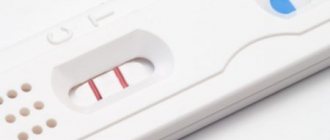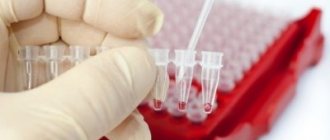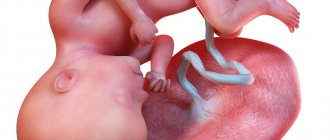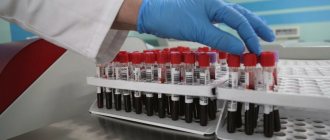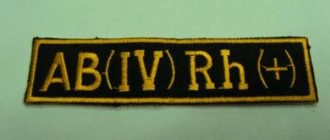In total, a person has four blood groups and two variants of the Rh factor: positive and negative. The most common variety is the first, the rarest is the fourth. About 75% of the population have a positive Rh factor, while the rest are negative. Inheritance of these two indicators occurs in utero, they do not change throughout life and are inherited from parents.
What does blood type depend on?
This trait is transmitted to children from parents and is determined by the antigenic system (the most common is AB0). According to it, special protein structures are present or absent in the blood - agglutinogens (A and B) on red blood cells and agglutinins (alpha and beta) in the blood plasma. Depending on the composition of the biological fluid, the following types are distinguished:
- Group I (0) - red blood cells do not contain agglutinogens, both types of agglutinin are present in the plasma;
- Group II (A) - agglutinogen A is noted on erythrocytes, agglutinin beta is noted in plasma;
- Group III (B) - erythrocytes contain agglutinogen B, plasma - agglutinin alpha;
- Group IV (AB) - both agglutinogens are present on erythrocytes, but not a single agglutinin is present in the plasma.
The presence of the same agglutinogen and agglutinin in the blood (A and alpha, B and beta) is not possible, since in this case the blood components are incompatible with each other, instantaneous gluing of red blood cells occurs - an agglutination reaction - which leads to the death of a person. This situation is possible when transfusion of incompatible biological fluid. With the natural formation of fetal blood, this situation does not arise.
Options for inheriting group affiliation
The genotype of both one and both parents can be homozygous (with two identical alleles in the gene - AA or BB) or heterozygous (that is, have two different alleles - dominant and recessive - Aa or BB). Therefore, different combinations are possible in children (a baby may have indicators different from those of their mother and father).
READ ALSO: Causes and symptoms of Rh conflict during pregnancy
The pattern of a child’s inheritance of a blood type from its parents is presented in the table:
| Father | Mother | Child |
| I (0) | I (0) | I |
| II (AA) (A0) | I, II | |
| III (BB) (B0) | I, III | |
| IV (AB) | II, III | |
| II (AA), (A0) | I (0) | I, II |
| II (AA) (A0) | I, II | |
| III (BB) (B0) | I, II, III, IV - any | |
| IV (AB) | II, III, IV | |
| III (BB), (B0) | I (0) | I, III |
| II (AA) (A0) | I, II, III, IV - any | |
| III (BB) (B0) | I, III | |
| IV (AB) | II, III, IV | |
| IV (AB) | I (0) | II, III |
| II (AA) (A0) | II, III, IV | |
| III (BB) (B0) | II, III, IV | |
| IV (AB) | II, III, IV |
The blood types of parents and child do not always match. The option is absolutely normal when the mother and father, for example, have varieties II and III, and their baby has IV.
What is blood?
The human body is a complex system. All organs, tissues and cells have their own function in the functioning of the body, and their coordinated work determines the state of human health. Blood is perhaps the most important of all organs.
Blood is a red liquid that connects tissues, circulating from the heart and to all parts of the human body, while providing vital processes. It transports gases, useful particles and microelements so that cellular exchange is correct and harmonious.
The heart pumps red fluid throughout the body, which in turn transports oxygen from the lungs and carbon dioxide back.
The structure of blood has two important components - the liquid part (plasma) and the formed elements contained in it (suspended cells). The latter include leukocytes, platelets, and erythrocytes. Red cells carry oxygen throughout the body and make up about 50% of all cells.
At the same time, the cells are filled with iron and capacious protein. Oxygen transfer is possible only in the presence of iron ions.
Hemoglobin is a family of proteins called “globin”, and the rest of the iron-containing part is called “heme”.
Age and body composition are the main parameters that determine the amount of blood in the human body. Its volume in an adult with a normal build is 4.5 -5 liters. The intensity of the color of the red liquid determines the percentage of oxygen.
Blood transfusion
Matching the group and Rh factors is important not only for conceiving a child. These indicators are of great importance when transfusing donor fluid to a sick person. It is believed that for a certain group only the same blood can be used. In fact, this is a misconception, since the acceptance or rejection of blood depends on the types of antigens.
The first type is considered universal, but also the most dangerous. In such blood, natural antibodies can block antigens in human plasma with a different group. In modern medicine, multi-group transfusions are rarely used; they try to adhere to a certain ratio:
- the first type is suitable for all groups, but it is important to take into account the full composition and Rh factor;
- the second - the same type and the third;
- the third - to its own type and the fourth;
- the fourth can only be transfused to a person with the same group.
The most common is the second positive blood type, and the rarest is the fourth negative. A reverent attitude towards donors with the latter group is observed in blood banks. AB plasma is suitable for absolutely everyone, but it is practically not used in medicine due to its rarity.
AB0 system. Types of blood groups. Their role in conceiving a child
The AB0 system classifies red liquid. It was created by Karl Landsteiner, an Australian geneticist. Two types of people A and B took part in the research.
The professor and his team combined blood plasma (from people A) with red cells (from people B). Combinations were noted in which erythrocytes stuck together and lumps formed (agglutination), but in other variations this did not happen.
When studying the structure of red cells (erythrocytes) and conducting research, the geneticist isolated specific substances in them - antigens.
Antigens are divided into 3 classes, respectively: A and B and 0. Both, one of them, or neither can be present in human blood. This conditionality became the basis for its distribution into 4 groups:
- Ⅰ (0) – AB antigens are absent (therefore, 0 in brackets)
- Ⅱ (A) – there is antigen A
- Ⅲ (B) – accordingly there is antigen B
- Ⅳ (AB) – both antigens are present
The most common blood groups in people are the second and third blood groups, the rarest are the first and fourth.
In the 21st century, genetics has risen to a very high level. At the stage of planning and conceiving a baby, you can find out the child’s blood type; for this, the parents’ data is sufficient. The baby will take one of the genes from the father, and one from the mother.
Genetics of blood type inheritance
To make it easier to understand the mechanisms of inheritance of a person’s blood type, we need to remember some basic principles of genetics.
It is well known that a person normally has 23 pairs of chromosomes (46 in total), of which 22 pairs of autosomes and one pair of sex chromosomes (XX or XY), which determines the sex of the child at birth.
A gene is a structural and functional unit of heredity, a carrier of various characteristics, and each chromosome consists of several thousand genes, i.e., it carries a large number of human characteristics.
At the same time, until the moment of fertilization, each mature human sex cell has only 23 chromosomes, so that when the nucleus of an egg cell fuses and is fertilized by a sperm, the total number of chromosomes is doubled, 46, i.e. 23 pairs.
Thus, the unborn child receives them equally from the father and from the mother. In this case, a paired set of chromosomes also provides a paired set of genes that provide the same characteristics. In this case, two options are possible.
The parents have the same genes, and their carrier is considered homozygous.
If the parents' duplicate genes responsible for one of the traits turn out to be different, then their carrier for this trait is considered heterozygous. In this case, the characteristics of one of the genes come to the fore.
The second one can maintain his independence, although his traits do not appear in this case.
The gene whose characteristics (hair color, eye color, body type, etc.) are more pronounced is called dominant, and the gene of the second parent with suppressed or hidden characteristics is called recessive. At the same time, you should always remember about this gene, which after a generation can become dominant and appear in the next generation.
To designate a person with O (I) blood type in genetics, gene0 gene0 is used.
Blood groups II and III can have two genetic variants:
- A (I) group - homozygous geneA geneA, heterozygous - geneA and gene0
- B (III) group - homozygous - geneB geneB, heterozygous - geneB gene0
In the last two cases, in the heterozygous variant, the first genes are dominant, and the second are recessive.
AB (IV) group - carriers of two different, but not dominant genes - gene A and gene B. In this case, both genes are fully expressed.
Before considering the inheritance of blood type using examples, it must be said once again that when genes are passed on to a child, a recessive gene can take a dominant position.
Mendel's law
The AB0 system gave impetus to a more detailed study of the characteristics of blood. The next stage in the research confirmed scientists’ assumptions about the possibility of transferring genes and blood type from parents to baby. The Austrian biogeneticist Mendel, in the second half of the 19th century, classified this heredity.
According to Mendel's law, there are 5 groups:
- If both parents have the first, children are born with the absence of antigen A and B - type
- Combination First plus Second, as well as First plus Third – children with corresponding groups
- Parents with the Fourth can have children of any group, as an exception, the First - everything can happen, even regardless of what antigens the spouse has
- Partnership of the Second with the Third gives any of the four
- “Bombay phenomenon.” In Hindus, antigens A and B, which are in the blood, do not actively manifest themselves.
Causes of Rh conflict
You've probably heard the concept of Rh conflict more than once? What exactly is it, and on what principle does it operate? As we found out earlier, it is impossible to accurately determine the Rh factor of the unborn child, but one can only assume with a degree of probability the relationship to one or another Rh factor. There is no chance to influence this process, and in most cases such a need does not arise. But sometimes it happens that during pregnancy there is a Rh conflict. This problem may bother expectant mothers whose blood lacks protein, i.e. Rh negative. This conflict is somewhat rare and occurs in less than 2% of cases, but there is indeed cause for concern.
Rh conflict is a kind of rejection of a positive fetus by the body of a negative mother. By the immune system, the presence of a positive Rh factor in the body is perceived as a foreign body, a bacterium, and therefore the immune system, like the entire body, tries to get rid of the unwanted element.
You should not get hung up on the possibility of getting a Rh conflict; in this matter, the main thing is to promptly monitor the level of antibodies in the body. To do this, you need to donate blood once a month, and after 30 weeks of pregnancy several times a month. If you have concerns about a possible Rh conflict, you can vaccinate with anti-Rh immunoglobulin. This vaccination can be given both before pregnancy and after it occurs.
The issue of inheritance in the ABO system and the Rh factor is quite complex and interesting. And as you can see, it is often impossible to 100% determine the Rhesus of the unborn baby, and it is absolutely impossible to influence this process in any way. Nature, taking into account genetic characteristics, will independently determine the future Rh and blood type of your baby. This is not a reason to worry, because in the future you will have to determine many things in your child’s life.
Parents' blood type and its effect on the sex of the child
Let's consider possible variations:
- The mother has Ⅰ (0), and the father Ⅰ (0) or Ⅲ (B) - the chances are 50% to 50%, there can be either a girl or a boy
- Mom has Ⅱ (A), and dad has Ⅱ (A) or Ⅳ (AB) - 99% girl
- Mom has Ⅲ (B), and father has Ⅰ (0) - 99% girl
- Mom has Ⅳ (AB), and dad has Ⅱ (A) - 99% girl
This technique should not be taken as completely reliable; Mother Nature always has the last word.
How does the Rh factor affect the course of pregnancy?
The woman’s well-being does not change; upon examination, the doctor finds no pathologies. Whether the Rh conflict affects the development of the embryo depends on the Rhesus the woman has and whether its early diagnosis is important. If positive, the fetus develops without deviations, so the pregnancy proceeds comfortably. This is due to the fact that the body produces protective IgG antibodies, considering the embryo to be a foreign object.
A conflict with negative Rh in a woman can lead to fetal rejection and premature birth against the background of hemolytic pathology in the fetus.
The severity of the disease can vary - from mild jaundice to disruption of the internal organs. With pathology, fetal death is possible at 20-30 weeks.
Probability of Rh conflict
The compatibility table of partners' Rh factors will allow you to assess the risk of pathologies in the fetus.
| Father's Rh factor | Mother's Rh factor | Child's resus factor | Conflict forecasting (in %) |
| + | + | + | 0% |
| + | — | 50% (+) or 50% (-) | 50% |
| + | + | 50% (+) or 50% (-) | 50% |
| + | — | — | 0% |
Consequences and ways to solve the problem
Rh conflict develops due to the production of protective bodies by the woman’s body. As a result, hemolytic pathology of the newborn is formed, which can manifest itself in three forms:
- Jaundice. Detected in 88% of cases. The baby's skin is characterized by an orange tint, which then becomes pale yellow. Symptoms: muscle weakness, swelling of the fontanel, enlarged spleen, tension in the neck muscles, tremor, pulse 100 beats per minute. The consequence may be a disruption in the functioning of the central nervous system: cerebral palsy, paralysis, paresis or delay in general development.
- Anemic. Occurs in 10% of cases. Due to the synthesis of antibodies by the pregnant woman's body, the level of hemoglobin in the child's blood decreases, which causes anemia. Symptoms: lethargy, pale skin and mucous membranes, enlarged liver and spleen. This form of pathology does not lead to the development of serious diseases in the child.
- Edema. It is found in 2% of cases, but is the most dangerous form. Symptoms: swelling of the limbs and torso, pale skin, severe enlargement of the liver and spleen. This leads to irreversible consequences. The child dies or becomes disabled.
If the risk of complications is high, the woman needs medical help to prevent the threat of miscarriage. Therapy includes a set of measures: tests, examinations and preventive measures.
At 27-30 weeks, the woman is prescribed a course of immunoglobulin injections to partially block antibodies, which ensures comfortable development of the fetus. The procedure weakens the woman’s immunity, so it will be difficult for the body to cope with even a mild cold.
Plasmapherosis is also performed to suppress antibodies and replace them with saline or vitamins. The procedure is prescribed at the following stages:
- pregnancy planning;
- identification of Rh conflict;
- a significant increase in the concentration of antibodies in the blood at any time.
In severe cases, transfusions cannot be avoided. The procedure is carried out at 22 weeks of gestation and involves transfusion of donor blood with characteristics similar to that of a fetus through the umbilical vein. This helps prevent miscarriage. The procedure is indicated when a woman is diagnosed with polyhydramnios, thickening of the placenta and umbilical veins. A transfusion is necessary if a significant enlargement of the fetal liver is detected by ultrasound.
Rhesus (Rh) How is it transmitted to the child?
What is rhesus? What is its effect on the intrauterine development of the fetus? Rhesus or Rhesus factor are lipoproteins (complex proteins) that live in the membrane of red blood cells.
85% of people have it, and the remaining 15% do not have complex protein at all. The first are classified as Rh positive (Rh+), and the second are Rh negative (Rh-). To establish the rhesus of a newborn, blood is taken from the heel and one pair of genes is examined.
A positive Rh factor (Rh+) is dominant and is designated DD (completely positive) or Dd (partially positive - heterozygous). Rh negative (Rh-) is recessive (weak) and is symbolized by dd. In the case when both parents have a Dd combination, that is, there is a clear dominant and recessive trait in the blood, they will be Rh positive.
Regarding their offspring - 75% that they will be positive and 25% - negative. If both parents or only one are Rh positive, the child can inherit both the plus and minus. Parents with a minus, children will only be Rh negative.
In genetics there is a definition of “Rh - conflict”. A very dangerous answer from a mother for a baby. This is due to the fact that when the baby’s red blood cells enter the mother’s blood, the mother’s body begins to produce antibodies against them.
Antibodies cause hemolytic disease of the fetus, which can lead to jaundice or anemia in the newborn, or worse, miscarriage. Mutations also happen. The gene set and number of red blood cells of an infant differs significantly from the gene set of the parents. Such a case is rare and happens once in a million.
How is the Rh factor inherited?
It happens that both parents, having a Rh positive factor, have a child with a Rh negative factor. This strange phenomenon is not difficult to explain. In 85 cases out of 100, people have a positive Rh factor, but if a woman has a negative Rh factor, then the persistence of a negative Rh factor can last for generations. Her Rh-positive children may give birth to “Rh-negative” children.
How are traits inherited?
At a time when ultrasound machines did not exist, people could only fantasize and imagine how their baby would be born.
Today this question has long ceased to exist. Using ultrasound, you can not only see the sex of the baby, but also notice some of its physiological characteristics.
Scientists around the world have developed many systems that suggest the likelihood of inheriting the color of a child's eyes, hair and skin from his parents. Even the ability to roll the tongue into a tube is a sign of inheritance, which will explain the presence of this skill in the baby.
Such unpleasant signs of inheritance as early gray hair or baldness, as well as myopia and gaps between teeth also occur.
Light eyes, musicality, straight hair and white skin are signs of rare inheritance. This means that the child most likely will not inherit them if one of the parents has dominant traits that are more actively inherited.
Positive group in a woman
Women with a positive blood type do not have to worry about Rh conflict.
The presence of a protein antigen in their blood allows them to easily conceive and bear a child with any Rh factor inherited from both parents. This happens due to the fact that the body, encountering the antigen for the first time, will try with all its might to overcome it and remove it from its blood system.
In the blood of a positive Rh factor, the protein is already present and is easily recognized by the maternal body in the fetus, if any. If the fetus inherits Rh negative, then the mother’s immunity simply has nothing to react to, and the pregnancy proceeds well.
